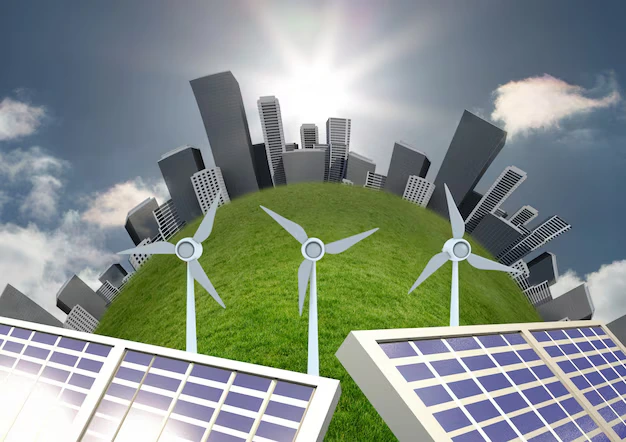 Step 2: Upgrade to Energy-Efficient Equipment
Step 2: Upgrade to Energy-Efficient Equipment
Outdated or inefficient equipment can significantly increase energy consumption. Upgrading to Energy Star-rated or other high-efficiency equipment can lead to immediate reductions in energy usage.
Examples of Energy-Efficient Equipment:
-
High-Efficiency HVAC Systems: These systems use less energy to maintain comfortable temperatures.
-
Energy-Efficient Office Equipment: Computers, printers, and servers that have been designed to consume less power during operation and in standby mode.
-
Variable Speed Drives (VSDs): VSDs for industrial machinery can regulate power consumption, ensuring energy is used more efficiently during operation.
 Step 3: Optimize HVAC Systems
Step 3: Optimize HVAC Systems
Heating, ventilation, and air conditioning (HVAC) systems account for a large portion of energy use in large commercial buildings. Ensuring that HVAC systems are running efficiently is crucial to reducing energy consumption.
How to Optimize HVAC Systems:
-
Regular Maintenance: Schedule routine maintenance to clean filters, repair leaks, and ensure all parts are functioning properly.
-
Programmable Thermostats: Use smart thermostats that automatically adjust temperature settings based on occupancy or weather conditions.
-
Zoning Systems: Implement zoning to control heating and cooling in specific areas of a building, rather than uniformly across the entire premises.
 Step 4: Use Energy-Efficient Lighting Solutions
Step 4: Use Energy-Efficient Lighting Solutions
Lighting is another major contributor to energy consumption, particularly in large offices or industrial facilities. Implementing energy-efficient lighting solutions can significantly reduce energy usage.
Energy-Efficient Lighting Strategies:
-
LED Lighting: Switch from incandescent or fluorescent bulbs to LEDs, which use up to 80% less energy and have a longer lifespan.
-
Motion Sensors and Timers: Install sensors in low-traffic areas like bathrooms and storage rooms to ensure lights are only used when needed.
-
Daylight Harvesting: Maximize natural light through windows or skylights, reducing the need for artificial lighting during daytime hours.
 Step 5: Implement Renewable Energy Sources
Step 5: Implement Renewable Energy Sources
Renewable energy offers businesses the opportunity to generate clean energy, reducing reliance on the grid and contributing to long-term energy savings. Large businesses can adopt a range of renewable energy technologies, such as:
-
Solar Panels: Install solar panels on rooftops or large grounds to generate electricity from sunlight.
-
Wind Energy: Businesses located in windy areas may benefit from wind turbines to generate renewable energy.
-
Geothermal Systems: Geothermal heating and cooling systems can efficiently regulate building temperatures by using the Earth's natural heat.
 Step 6: Employee Engagement in Energy Efficiency
Step 6: Employee Engagement in Energy Efficiency
Employees play a crucial role in reducing energy consumption. Engaging staff in energy-saving initiatives can lead to widespread behavioral changes that further enhance energy efficiency.
How to Engage Employees:
-
Awareness Campaigns: Educate employees on the importance of energy efficiency and how they can contribute by turning off lights and equipment when not in use.
-
Energy-Saving Competitions: Incentivize energy-saving behaviors by organizing competitions among departments to see who can reduce energy use the most.
-
Energy-Efficient Practices: Encourage energy-saving habits like using natural light, setting optimal thermostat levels, and using energy-efficient equipment.
 Step 7: Monitor and Review Energy Performance
Step 7: Monitor and Review Energy Performance
Once energy efficiency measures are implemented, it’s important to regularly monitor and review energy performance to ensure continued success. Use smart meters and energy management software to track usage, identify trends, and make further adjustments as needed.
Key Monitoring Strategies:
-
Real-Time Data: Use smart energy meters to collect real-time data on energy consumption and identify inefficiencies.
-
Benchmarking: Compare current energy use against industry standards or past performance to measure improvements.
-
Continuous Improvement: Regularly review energy data and adjust strategies as necessary to achieve ongoing energy savings.
 Conclusion: Long-Term Benefits of Energy Efficiency for Large Businesses
Conclusion: Long-Term Benefits of Energy Efficiency for Large Businesses
Implementing energy efficiency measures delivers both immediate and long-term benefits for large businesses. By conducting energy audits, upgrading equipment, and engaging employees, companies can significantly reduce operational costs while meeting sustainability goals. With the growing emphasis on green business practices, energy efficiency is no longer optional—it’s essential for staying competitive and reducing environmental impact.
Insight from UtilityKing
At UtilityKing, we partner with large businesses to implement tailored energy efficiency strategies that reduce costs and enhance sustainability. From energy audits to renewable energy adoption, our team provides expert solutions to optimize your energy performance.
 Introduction: The Importance of Energy Efficiency in Large Businesses
Introduction: The Importance of Energy Efficiency in Large Businesses
 Step 1: Conduct an Energy Audit
Step 1: Conduct an Energy Audit

